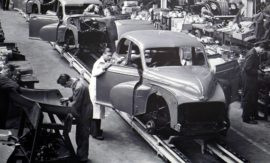Intended learning outcomes: Differentiate between the classical procedure and different archetypes of engineer-to-order. Describe the approach for basic and for repeatable engineer-to-order.
Although mass customization products are nearly all physically different, many companies that consider mass customization to be one of their core competencies view such products as “standard” products. This is because they can all be produced using a make-to-order process. For such companies, “non-standard” or “customized” are terms that refer to products that cannot be described with the configurator, and thus need an engineer-to-order environment. According to Figure 4.4.5.2, the engineer-to-order production environment is strongly related to products according to (changing) customer specification. According to Figure 4.5.2.1, nonrepetitive or “one-of-a-kind” production, often together with mass customization, are the corresponding production types. The customers’ requirements here, in terms of speed and cost, are not as stringent as for “standard” (mass customized) products, but in many branches they are getting closer to mass customization requirements. Also compare Figure 7.1.2.1.
Course section 7.4: Subsections and their intended learning outcomes

7.4 Generative and Adaptive Techniques for Engineer-to-Order (ETO)
Intended learning outcomes: Differentiate between the classical procedure and different archetypes of engineer-to-order. Describe the approach for basic and for repeatable engineer-to-order.

7.4.1 Classical Procedure and Different Archetypes of Engineer-to-Order (ETO)
Intended learning outcomes: Explain different archetypes in engineer-to-order: basic, repeatable, complex, non-competitive ETO.

7.4.2 Approach for Basic Engineer-to-Order
Intended learning outcomes: Explain the template for bill of material and routing sheet used to work out similar variants.

7.4.3 Approach for Repeatable Engineer-to-Order
Intended learning outcomes: Describe a typical engineer-to-order business process and its permanent enabling process. Explain role of the permanent engineer-to-order enabling process.
Course 7: sections and their intended learning outcomes

Course 7 – The Concept for Product Families and One-of-a-Kind Production
Intended learning outcomes: Produce logistics characteristics of a product variety concept. Explain adaptive and generative techniques in detail. Describe the use of generative and adaptive techniques for engineer-to-order. Differentiate various ways of cooperation between R&D and Engineering in ETO Companies.

7.1 Logistics Characteristics of a Product Variety Concept
Intended learning outcomes: Differentiate between high-variety and low-variety manufacturing. Describe different variant-oriented techniques, and the final assembly schedule.

7.2 Adaptive Techniques
Intended learning outcomes: Explain techniques for standard products with few variants as well as techniques for product families.

7.3 Generative Techniques
Intended learning outcomes: Disclose the combinatorial aspect and the problem of redundant data. Present variants in bills of material and routing sheets as production rules of a knowledge-based system. Explain the use of production rules in order processing.

7.4 Generative and Adaptive Techniques for Engineer-to-Order (ETO)
Intended learning outcomes: Differentiate between the classical procedure and different archetypes of engineer-to-order. Describe the approach for basic and for repeatable engineer-to-order.

7.5 Cooperation between R&D and Engineering in ETO Companies
Intended learning outcomes: Describe different means used for cooperation between the R&D and the order-specific engineering departments. Present the portfolio of cooperation types between R&D and engineering in ETO companies.

7.6 Summary
.

7.7 Keywords
.

7.8 Scenarios and Exercises
Intended learning outcomes: Apply adaptive techniques for product families. Disclose the use of production rules in order processing. Elaborate the setting the parameters of a product family.
